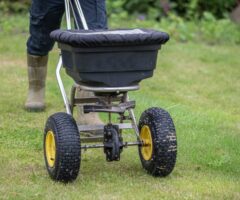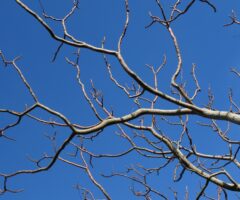Heavy blankets of snow and thick coatings of ice are the calling cards of Mid-Michigan winters. But freezing rain, icy conditions, and snowstorms can be highly damaging to your shrubs and trees. If you’re worried about your snow-covered shrubs or ice-laden trees, there are things you can do – and things you should not do – to help them recover.
In this article, we cover:
- the signs of winter snow and ice damage to look for,
- do’s and don’ts to help shrubs recover from heavy winter loads, and
- a few tips for when it’s time to call in the professionals to inspect or treat your shrubs.
How Snow and Ice Can Damage Shrubs
Broken Limbs and Branches
After a big storm, heavy and tightly packed loads of snow can collect on top of and between the branches and twigs of your shrubs and trees. After a certain point, the accumulated weight becomes too much for branches to bear and they begin to bend. Sometimes, this allows the snow to slide off naturally, alleviating the load.
But sometimes the branches break instead of bending. Branches turn brittle from low or freezing temperatures and lose their natural flexibility, making them more likely to break in winter.
Frost Cracking
When daytime temperatures warm, woody plant tissue responds by expanding. As soon as temperatures begin to drop again, tissues start to contract. The outer bark can contract more quickly than the inner wood, sometimes causing it to crack as it shrinks. If you’ve ever heard loud popping sounds at night (some people say it sounds more like a rifle shot), it’s probably frost cracks forming on trees.
If the tree or shrub was healthy, the fissures may seal up in spring. But, sometimes, open cracks remain and create openings for fungal diseases to attack the vulnerable interior wood. That’s one of the many reasons why a thorough spring inspection is so important for all your woody plants.
Damaged or Dead Growth
When late snow and ice storms happen after new growth has begun, tender new buds and leaves can freeze and die back. Frustratingly, that same snow can also be insulating! When winter storms bring extended periods of low or freezing temperatures, it’s the exposed leaves and branches that can be damaged while the buried portions are protected from extreme temperatures.
Salt Damage
Roads and sidewalks are often treated with road salt (or other “ice melt” products) to keep them from being coated with dangerous ice. While it may be beneficial to us (at least from a slip-and-fall perspective), road salt is notoriously damaging to plants. If you notice brown, dead patches on shrubs in late spring, it’s probably because of salt burn. When plants are dehydrated during winter, damage from road salt intensifies.
Desiccation or Winter Burn
Leaves on broadleaved evergreens, as well as smaller branches, can dry out and die during winter. Usually, this is caused by drying winds, extended periods of low temperatures, or insufficient available water.
Do’s & Don’ts to Help Your Shrubs
After a storm passes, wait a little while to see what the weather brings. If temperatures rise and the skies remain clear, some or all the snow and ice may naturally melt and fall off. This is the best outcome. But if it doesn’t happen, you should be prepared to help your plants recover. Here’s what to do and what not to do.
- Do brush snow off your shrubs. Using a broom or a flexible rake, you can carefully brush snow off the branches and foliage of your plants that you can reach while standing. This will help reduce the weight of snow and will also relieve the intensity of branch bending that can lead to breakage.
- Don’t whack at your shrubs with that broom or rake. You can further damage your already brittle plants if you hit them hard to knock off snow and ice. Just brush off what you can – don’t wallop them.
- Do gently shake branches to dislodge snow. The operative word here is “gently. You’re not trying to bend branches, just move them enough to help snow fall off them.
- Do prune off damaged branches that you can reach from the ground, as long as they’re the right size for your tools and your level of pruning experience.
- Don’t get on a ladder to reach broken, hanging, or damaged branches.
- Don’t stand underneath a tree or large shrub while knocking snow and ice off branches. Snow and ice loads are unpredictable and can fall right on your head. This won’t be like it is in cartoons—you can be seriously injured or worse. And snow and ice can bring down brittle or damaged branches (and electrical lines) along with them, adding to the danger.
- Never, ever stand beneath branches that you’re pruning. Need we say more?
- Don’t prune if you don’t know how to do it correctly. A valuable specimen shrub or tree can be permanently damaged from poor pruning. If in doubt, call in a trained professional.
- And please, please, please don’t DIY your downed branches with power tools when you’re working on slippery, icy surfaces. We shouldn’t have to list any reasons why that’s a bad idea.
- Do water your shrubs if the winter is dry and cold. If temperatures are high enough in the late morning or at noon to warm the soil, give your plants a drink of water. This will keep them hydrated and better able to withstand recurring cold temperatures.
- Don’t spray your plants with a hose to wash off snow and ice. Those warmer daytime temperatures can drop quickly and you don’t want to add another layer of ice to branches and leaves! That same water can also freeze on your paved areas, increasing the chances of you slipping and falling.
- Do remove dangerous snow loads from your eaves or overhangs (but do so carefully!!). Falling snow can crush foundation plantings or snap brittle branches. Don’t increase the chance of damaging your plants by further loading them with snow and ice.
- Don’t shovel snow onto your shrubs. If you have space, piling snow off to the side of your driveway and entryway is the best way to keep your car and house readily accessible.
- Don’t use a snow shovel near the base of your shrubs, as you can damage snow-covered surface roots or bark with the sharp edges of a shovel.
NOTE: Call your city’s public works department if a street tree has fallen or if branches are blocking a road or sidewalk. If ice and fallen limbs are on your property, call an experienced, certified Arborist to assess.
When Spring Arrives
After the snow has melted in spring, take a close look at your ornamental shrubs and trees.
- Are there broken, cracked, or hanging branches?
- Are any of your shrubs still split apart or bent to the ground (we commonly see this in evergreens like arborvitae, yews, and junipers)?
- As new growth emerges, do you see evidence of dieback or browning?
These are just some of the issues caused by winter snow or ice loads, or salt damage from de-icing. If you notice any of these signs, particularly on shrubs that were recently planted, give us a call. We’ll inspect your shrubs and give you a plan to help them fully recover.






